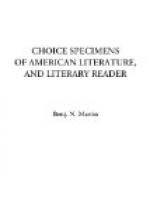... The route that affords the bravest winds, the fairest sweep, and the fastest running to be found among ships, is the route to and from Australia. But the route which most tries a ship’s prowess is the outward-bound voyage to California. The voyage to Australia and back, carries the clipper ship along a route which, for more than three hundred degrees of longitude, runs with the “brave west winds” of the southern hemisphere. With these winds alone, and with their bounding seas which follow fast, the modern clipper, without auxiliary power, has accomplished a greater distance in a day than any sea-steamer has ever been known to reach. With these fine winds and heaving seas, those ships have performed their voyages of circumnavigation in sixty days.
[Footnote 62: Formerly an officer of the navy, eminent for his scientific researches and writings on maritime subjects; a native of Virginia.]
* * * * *
=_251._= THE GULF STREAM.
As a rule, the hottest water of the Gulf Stream is at, or near, the surface; and as the deep-sea thermometer is sent down, it shows that these waters, though still far warmer than the waters on either side at corresponding depths, gradually become less and less warm until the bottom of the current is reached. There is reason to believe that the warm waters of the Gulf Stream are nowhere permitted, in the oceanic economy, to touch the bottom of the sea. There is everywhere a cushion of cool water, between them and the solid parts of the earth’s crust. This arrangement is suggestive, and strikingly beautiful. One of the benign offices of the Gulf Stream is to convey heat from the Gulf of Mexico, where otherwise it would become excessive, and to dispense it in regions beyond the Atlantic, or the amelioration of the climates of the British Islands and of all Western Europe. Now cold water is one of the best non-conductors of heat, and if the warm water of the Gulf Stream was sent across the Atlantic in contact with the solid crust of the earth,—comparatively a good conductor of heat,—instead of being sent across, as it is, in contact with a cold non-conducting cushion of cool water to fend it from the bottom, much of its heat would be lost in the first part of the way, and the soft climates of both France and England would be, as that of Labrador, severe In the extreme, icebound, and bitterly cold.
* * * * *




